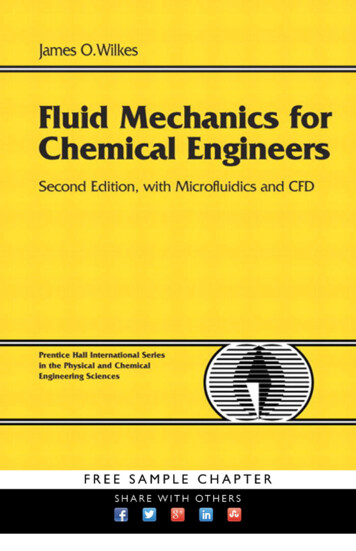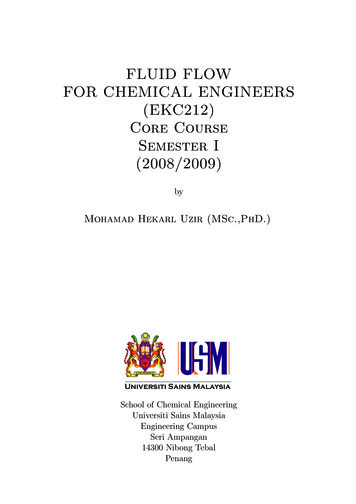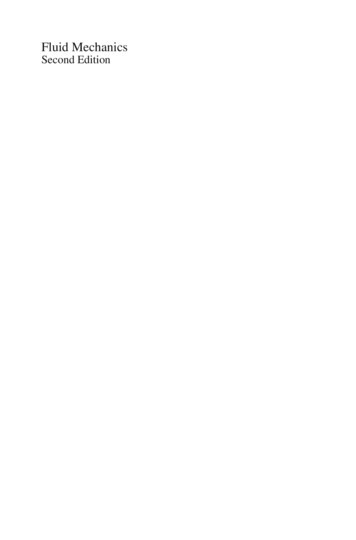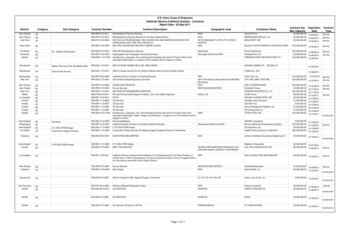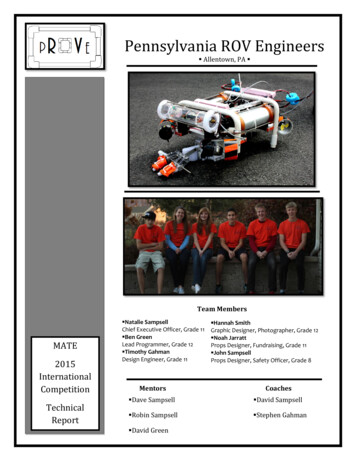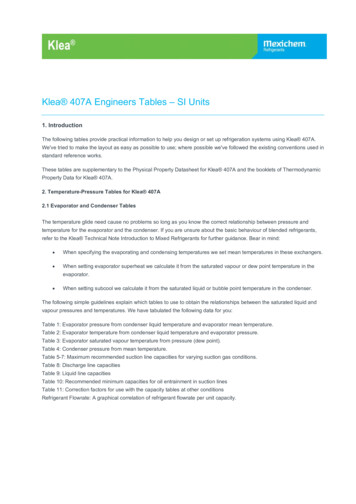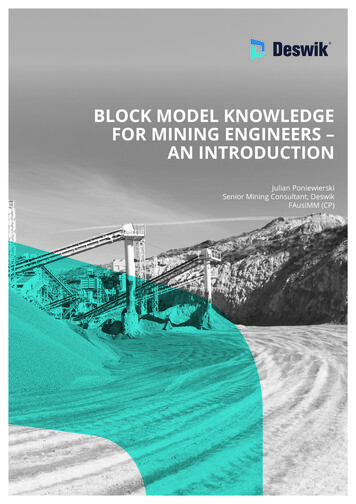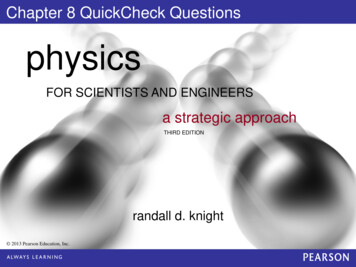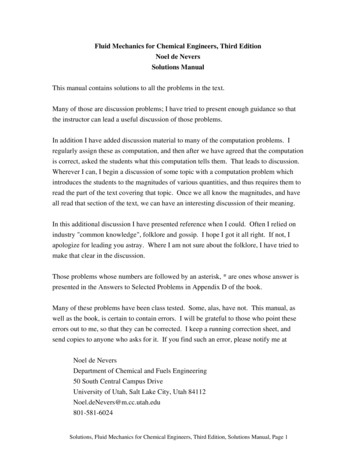
Transcription
Fluid Mechanics for Chemical Engineers, Third EditionNoel de NeversSolutions ManualThis manual contains solutions to all the problems in the text.Many of those are discussion problems; I have tried to present enough guidance so thatthe instructor can lead a useful discussion of those problems.In addition I have added discussion material to many of the computation problems. Iregularly assign these as computation, and then after we have agreed that the computationis correct, asked the students what this computation tells them. That leads to discussion.Wherever I can, I begin a discussion of some topic with a computation problem whichintroduces the students to the magnitudes of various quantities, and thus requires them toread the part of the text covering that topic. Once we all know the magnitudes, and haveall read that section of the text, we can have an interesting discussion of their meaning.In this additional discussion I have presented reference when I could. Often I relied onindustry "common knowledge", folklore and gossip. I hope I got it all right. If not, Iapologize for leading you astray. Where I am not sure about the folklore, I have tried tomake that clear in the discussion.Those problems whose numbers are followed by an asterisk, * are ones whose answer ispresented in the Answers to Selected Problems in Appendix D of the book.Many of these problems have been class tested. Some, alas, have not. This manual, aswell as the book, is certain to contain errors. I will be grateful to those who point theseerrors out to me, so that they can be corrected. I keep a running correction sheet, andsend copies to anyone who asks for it. If you find such an error, please notify me atNoel de NeversDepartment of Chemical and Fuels Engineering50 South Central Campus DriveUniversity of Utah, Salt Lake City, Utah ons, Fluid Mechanics for Chemical Engineers, Third Edition, Solutions Manual, Page 1
FAX 801-585-9291Many of the problems go beyond what is in the text, or show derivations which I haveleft out of the text to make it read easier. I suggest that the instructor tell the students toat least read all the problems, so that they will know what is contained there.Some of the problems use spreadsheets. In the individual chapters I have copied thespreadsheet solutions into the text in table format. That is easy to see, but does not let thereader modify the spreadsheets. In the Folder labeled "Spreadsheets" I have includedcopies of all the spreadsheets shown in the individual chapters, and also the high velocitygas tables from the appendices. These are in Excel 4.0, which is compatible with all laterversions.Noel de NeversSalt Lake City, Utah, 2003Solutions, Fluid Mechanics for Chemical Engineers, Third Edition, Solutions Manual, Page 2
Fluid Mechanics For Chemical Engineers, Third EditionNoel de NeversSolutions ManualChapter 1 An * on a problem number means that the answer is given in Appendix D ofthe book.1.1 Laws Used, Newton's laws of motion, conservation of mass, first and second laws ofthermodynamics. Laws Not Used, third law of thermodynamics, all electrostatic andmagnetic laws, all laws discussing the behavior of matter at the atomic or subatomiclevel, all relativistic laws.1.2 By ideal gas law, for uranium hexafluoride ρ (1 atm ) 352g mol PMLglbm 0.0130 0.816333RT10 cmcmftL atm (56.2 273.15 K) 0.082 mol K Here the high density results from the high molecular weight.At its normal boiling point, 4 K, by ideal gas law helium hasρ PM1 4glbm 0.012 3 0.76 3RT 0.082 4cmftHere the high density results from the very low absolute temperature. The densities ofother liquids with low values are: liquid methane at its nbp, 0.42 gm/cm3, acetylene at itsnbp, 0.62, ethylene at its nbp, 0.57.Discussion; the point of this problem is for the students to recognize that one of theprincipal differences between liquids and gases is the large difference in density. As arule of thumb, the density of liquids is 1000 times that of gases.1.3*ρ mass volume:For 100lbm 50lbm50lbm lbm 102 3 33 ft 4.49 62.3lbm ft 62.3lbm ft ρ 100 lbm Solutions, Fluid Mechanics for Chemical Engineers, Third Edition, Chapter 1, page 1
Discussion; this assumes no volume change on mixing. That is a good assumption here,and in many other cases. In a few, like ethanol and water have changes of up to a few %.1.4 The maximum density of water occurs at 4 C, not at zero. The relation between themeter and the kg was defined to have the density of water at 4 C be 1.00 gm/cm3.However for various historical reasons it has ended up that the density of water at 4 C isabout 0.99995 gm/cm3.1.5*ρ ρ m gross m tareVm gross (m tareV45 g 17.24 gg 1.110325cmcm 3 mair ) 45 g (17.24 0.03) gg 1.1093cm 325cm Omitting the weight of the air makes a difference of 0.001 0.1%. This is normallyignored, but in the most careful work it must be considered.The plot covers the whole range ofpetroleum liquids, from propane (s.g. 0.5) to asphalts (s.g. 1.1). Water (s.g. 1) has 10 API.200150deg API1.6 This scale has the advantage that itplaces a higher number on lower densityoils. That matches the price structure foroil, where lower density crude oils havea higher selling price, because they aremore easily converted to high-pricedproducts (e.g. gasoline). Oil prices willoften be quoted as (A B·deg API) /bbl.where B 0.01/deg API.100500-500.5 0.6 0.7 0.8 0.9specific gravity11.1 specific M 1.7 For ideal gases, gas . For methane and propane the values are gravity ideal gas Mair16 / 29 0.55 and 44 / 29 1.51 . Propane is by far the most dangerous fuel in commonuse. If we have a methane leak, buoyancy will take it up and disperse it. If we have aleak of any liquid fuel, it will flow downhill on the ground, and be stopped by any ditchor other low spot. Propane, as a gas heavier than air, flows downhill, over smallobstructions and depressions. It often finds an ignition source, which methane orgasoline would not find in the same situation.Solutions, Fluid Mechanics for Chemical Engineers, Third Edition, Chapter 1, page 2
dV has dimension ft s 1 ;dy ofs ft has dimension lbf lbf ftlbm ft secmomentum 2 τ [ ] momentum flux2 [ ]2ft sec of ft lbm secarea time has dimension τlbf / ft 2lbm μ [ ][ ]1/ s of dV / dyft s1.81.9 Paints; not settle in the can. Inks; spread when you are writing, don't leak when youare not. Lipstick; spread when applied, then not move. Crayons; same as lipstick.Blood; corpuscles don't settle, viscous resistance is small in large arteries and veins.Chocolate; easy to spray on warm or apply by dipping, then does not run off until itcools. Oil well drilling fluids; low viscosity when pumped up and down the well,high viscosity when leaking out of the well into porous formations. Radiatorsealants; low viscosity in pumped coolant, high viscosity in potential leaks. Aircraftde-icing fluids; stick to the plane at low speeds, flow off at high speeds. Plaster,spread easily, not run once applied while it is setting. Margarine, spread easily, butremain solid when not being spread.1.10 (a) For r R, k 2 R2 Vθ ω R 02 1 k R For r rinner cylinder kR k 2 R2 k2 1 k2 RVθ ω kR ω ωkR k 1 k 2 kR 1 k2 (b) k2 d R2 k 2 2 R 2 d Vθ and ω 1ω dr r 1 k 2 dr r2 1 k 2 r3 k 2 2R2 d V σ r θ ω 1 k 2 r2 dr r Here we can ignore the minus sign, because as discussed in the text its presence orabsence is arbitrary. Then, at the surface of the inner cylinder r rinner cylinder kR and k 2 2R2 2 σ inner cylinder ω 2 2 ω 1 k2 1 k (kR) rD25.15 mm(c) Here k inner inner 0.9106 so thatRDouter 27.62 mm 12.26210 2π min σ inner cylinder 2 min 60 s 1 0.9106 sSolutions, Fluid Mechanics for Chemical Engineers, Third Edition, Chapter 1, page 3
6S πD2 , Cube with edge E,V π D3 D6π 22S 2 4 D πD6 π 3VDD41.11 Sphere,S 6E 2 6 3 Right cylinderVEEThis appears strange, but is correct. If we ask what is the surface area for each of thesefigures for a volume of 1 cm3, we find that for the sphere D (6 cm3/π)1/3 1.24 cm, forthe cube E 1 cm and for the right cylinder D (4 cm3/π)1/3 1.08 cm. Thus for equalvolumes the sphere has the least surface, the right cylinder the next least, and the cubethe most.1.12 Crystallization of supersaturated solutions, boiling in the absence of a boiling chip,a pencil balanced on its eraser, all explosives, a mixture of hydrogen and oxygen (in theabsence of a spark), a balloon full of air (in the absence of a pin), a charged capacitor.1.135280ft 323 3213 8000 mi 3.95 10 ft 1.12 10 m 66mi lbm m ρ V 5.5 62.4 3 (3.95 1022 ft 3 ) 1.35 1025 lbm 6.14 10 24 kg ft V π3D π There is no meaning to the term "the weight of the earth" because weight only hasmeaning in terms of a well-defined acceleration of gravity. For the earth there is no suchwell-defined acceleration of gravity. lbf s2lbm 6 ft 11.6lbf , (c) same as (a).1.14 (a) 62.3 lbm/ft3 , (b) 62.3 3 2 ft s 32.2 lbm ft 5280ft 3 1728 gal12 1.15* mile 3 1.1 10 gal , mi231 ftmi 330 10 gal 1.14mi3121.1 10 gal9The value in cubic miles is surprisingly small. We use about 5 E 9 bbl/yr, of which weimport about half. This suggests that at the current usage rate we have (30/(0.5·5) 12years of oil reserves. For the past half century this number has remained about constant,we have found it at about the rate we used it. In the past few years this has mostly beenby improved recovery methods for existing fields, rather than finding new fields. In the1950's the US could produce about twice as much oil as it consumed; now we canproduce about half. This is mostly not due to a decline in production, but an increase inconsumption.Solutions, Fluid Mechanics for Chemical Engineers, Third Edition, Chapter 1, page 4
gm equivalent 6.02 10 23 electrons 6.2 108 electronsgmequivalent96,5001.16coulomb 778 ft lbf 4.184 J 4.184 kJThis J is easily confused with the J for Btucalkcala joule. See any thermodynamics text written before about 1960 for the use of this J toremind us to convert from ft·lbf to Btu.1.17J 1 32.2 lbm ftlbm toof 1;toof 32.2 ft or2lbf s2lbf s32.2 lbm ftlbm ftsgc 1 1dnoces 22;lbf slbf dnoces32.21.18*gc 1 The toof and the dnoces are the foot and the second spelled backwards. No one hasseriously proposed this, but it makes as much sense as the slug and the poundal.1.19 lbm 52802 ft 2 2.71 10 6 lbmm acre ft ρV 62.3 3 ( ft) acre ft kg 2mhectare meter ρ V 998.2 3 (m )(100m) 9.98 106 kg mThe acre-ft is the preferred volume measure for irrigation because one knows, roughly,how many ft/yr of water one must put on a field, in a given climate to produce a givencrop. Multiplying that by the acres to be irrigated gives the water demand. TheColorado River, over which arid Southwestern states have been fighting for a centuryflows about 20 E6 acre ft/yr. The Columbia flows about 200 E 6 acre-ft/yr. The southwestern states look to the Columbia with envy; the Northwestern states are in no hurry togive it up.22 BTUmi ft lbf s2BTUc 2 186,000 5280 3.85 1013 lbms mi 32.2 lbm ft 778ft lbf22 m NsJJc 2 2.998 108 8.99 1016 s kg m N mkg1.201.21* 300 seconds is not the same as 300 lbf·s/lbm. So this terminology is wrong. But itis in very common usage.Solutions, Fluid Mechanics for Chemical Engineers, Third Edition, Chapter 1, page 5
Isp 300lbf s 32.2 lbm ftft 96602lbmlbf ssAs discussed in Ch. 7, this is the exhaust velocity if the exhaust pressure matches theatmospheric pressure. If they are different (the common case) then this value must bemodified. However European rocket engineers use the "effective exhaust velocity"which takes the pressure into account the same way US engineers use the specificimpulse.Btu 30.5cm 2 3600sq 1calBtu 1.33 10422hrA cm s 252cal ft hr ft21JBtu m 3600sBtuq 2 0.317hrhrft 2A m s 1.055J 3.281ft 1.22 ft lbm (0.5ft ) 10 62.3 3 DVρft s1.23* R μ1.002 cpcp ft 2lbf s2 4.6 10 5 52.09 10 lbf s 32.2lbm ft 0.5 m 10 998.2 kg 3 3.28 3.28 m m Pa m 2 Nm s5or R 2 4.6 101.002 10 3 Pa sN kg s cm 1 (1 cp )0.01gm atm cm s 2 s 0.99 10 8 cm2 1.06 10 11 ft 21.24Darcy 6atm cm s cp 1.01 10 gm 1 s N 0.1 m 0.0145 N 0.0033 lbf 1.48 g(force)m1.25* F 2σl 2 72.74 10 31.26oC 1.8 o F lbm 252calBtuX o 1.0oC 454 g Btulbm F gm calThe calorie and the Btu were defined in ways that make this 1.0. Some are confusedoooobecause F 1.8 C 32 , but if we differentiate, d F 1.8 d C which is the relationused above.Solutions, Fluid Mechanics for Chemical Engineers, Third Edition, Chapter 1, page 6
1.27 One standard atmosphere 1.013 bar. Clearly the bar is a convenient approximateatmosphere. It is very commonly used in high pressure work, as an approximateatmosphere. Meteorologists express all pressures in millibar. Currently thermodynamictables like steam tables and chemical thermodynamic tables show pressure in bars.1.28 The US air pollution regulations are almost all written for concentrations in(g/m3) and the models expect emission rates in (g/s). The available auto usage data isalmost all in vehicle miles per hour (or day or second) so to get emission rates in (g/s)one multiplies the (vehicle miles/s) times the emission factor in (g/mi). The US-EPAwould be happy to do it all in metric, but the mile doesn't seem to be going away veryfast in the US.1.291kg f 9.81N 10 4 cm2 98.1 kPa 0.968atm2 2mcmkg fThis is very close to one atmosphere. The most common type of pressure gage testers,the dead-weight
Solutions, Fluid Mechanics for Chemical Engineers, Third Edition, Solutions Manual, Page 1 . FAX 801-585-9291 Many of the problems go beyond what is in the text, or show derivations which I have left out of the text to make it read easier. I suggest that the instructor tell the students to at least read all the problems, so that they will know what is contained there. Some of the problems use .
